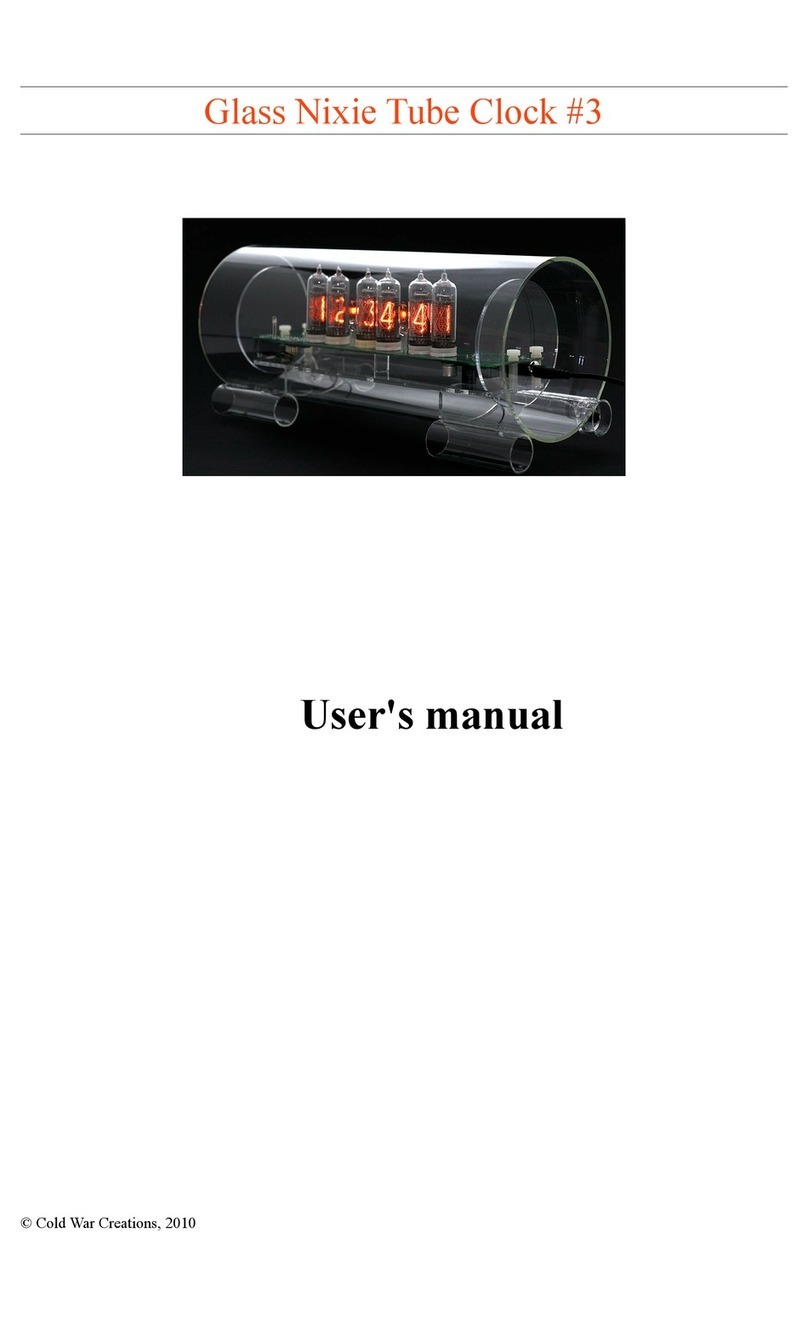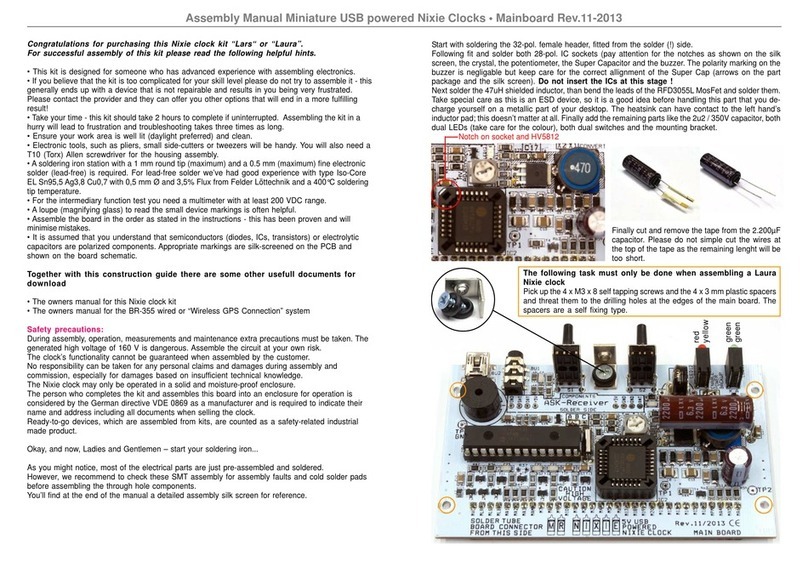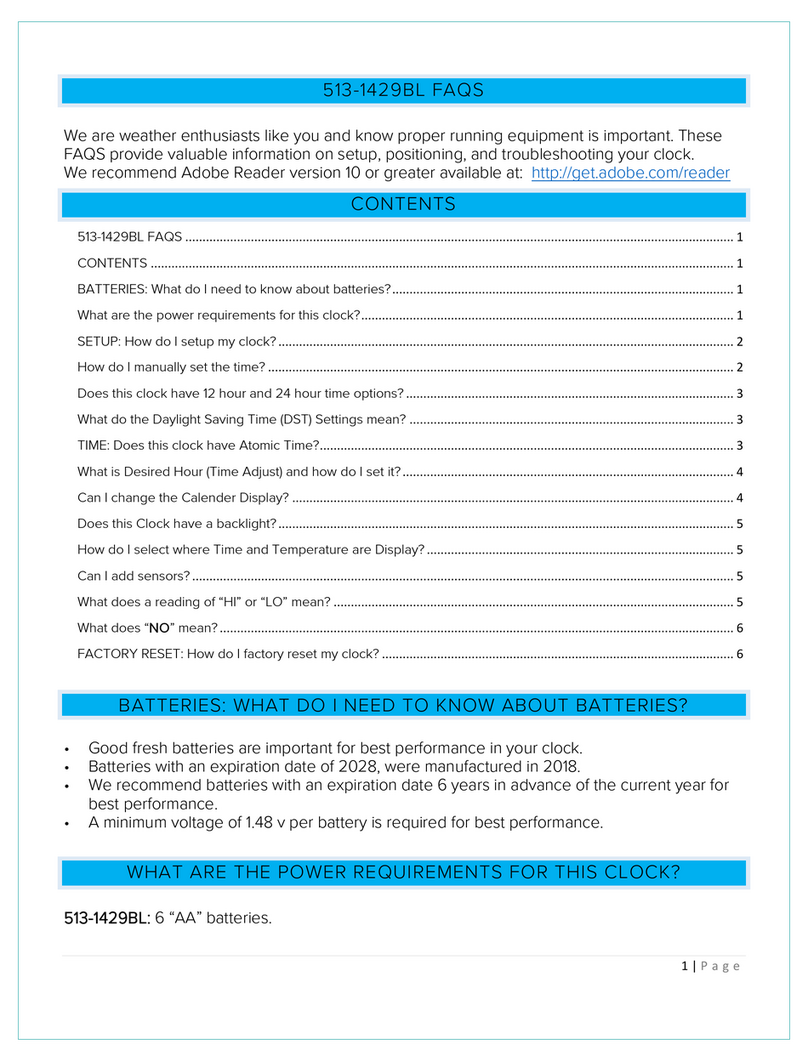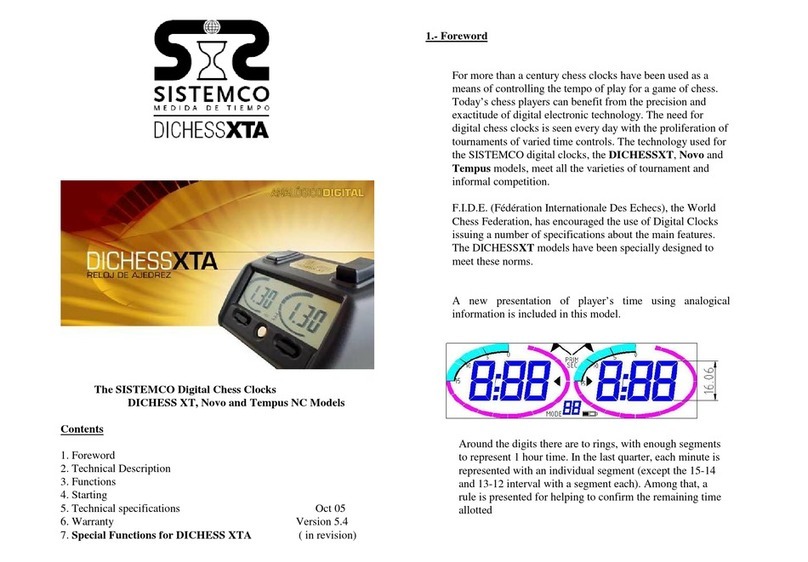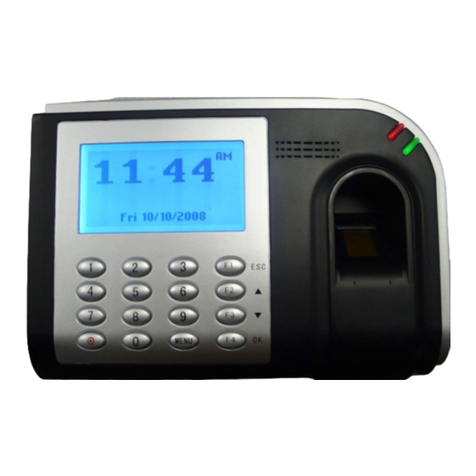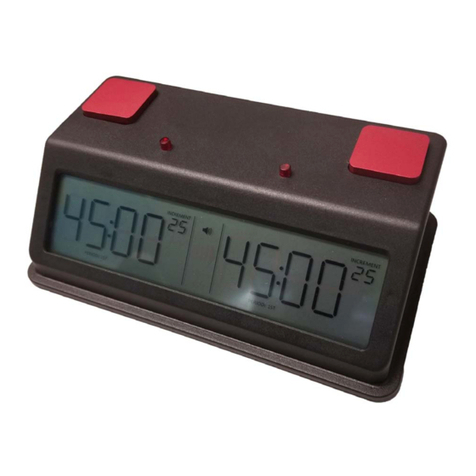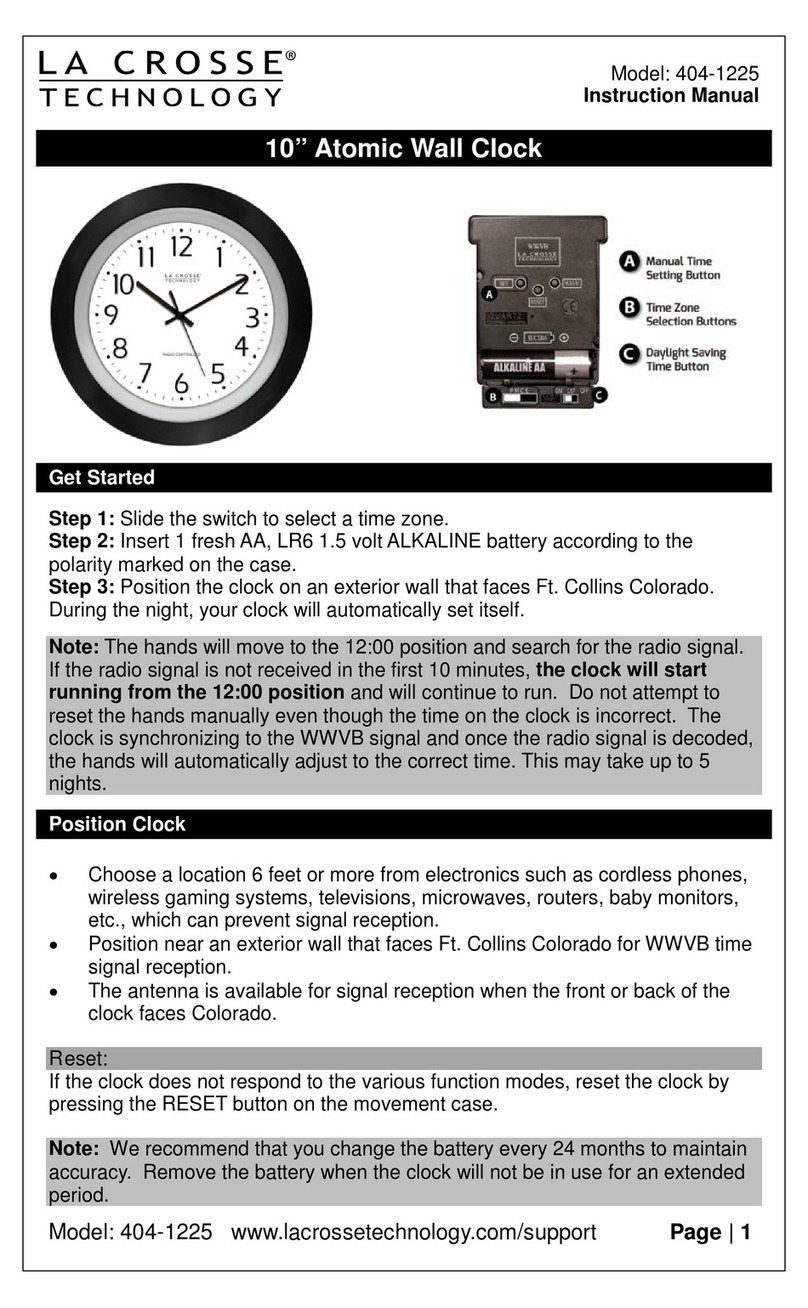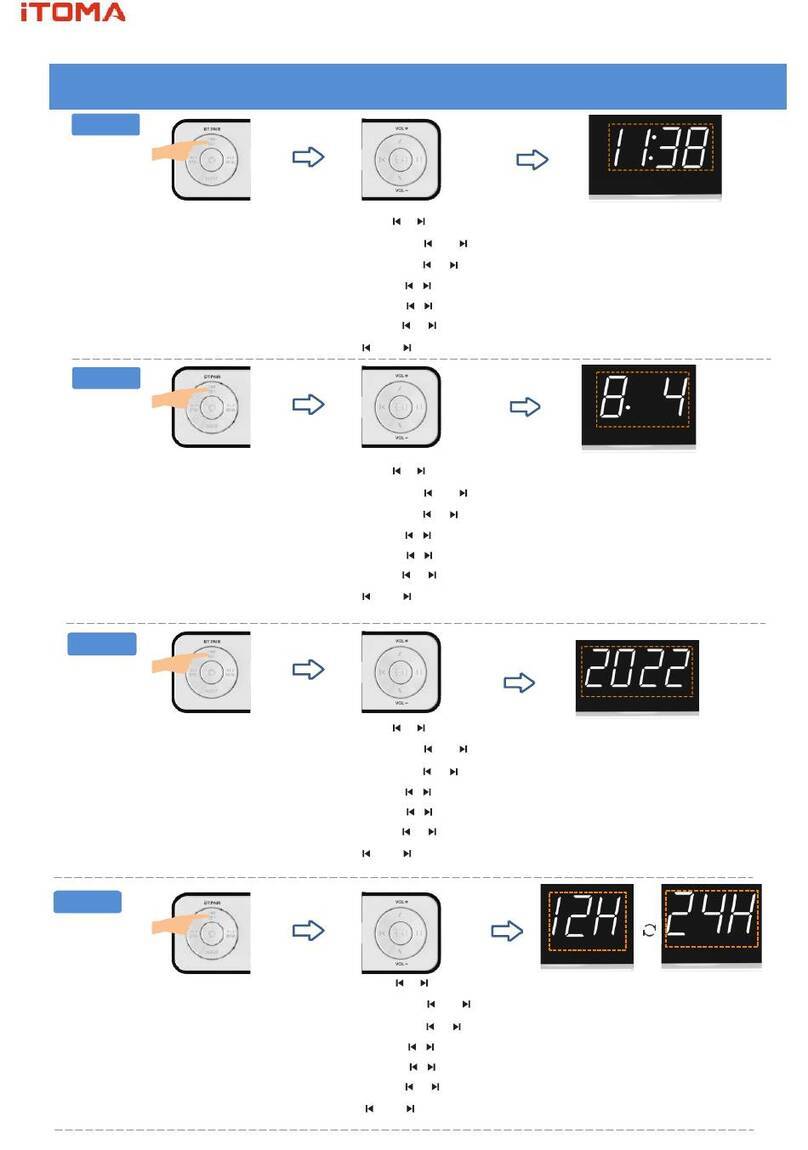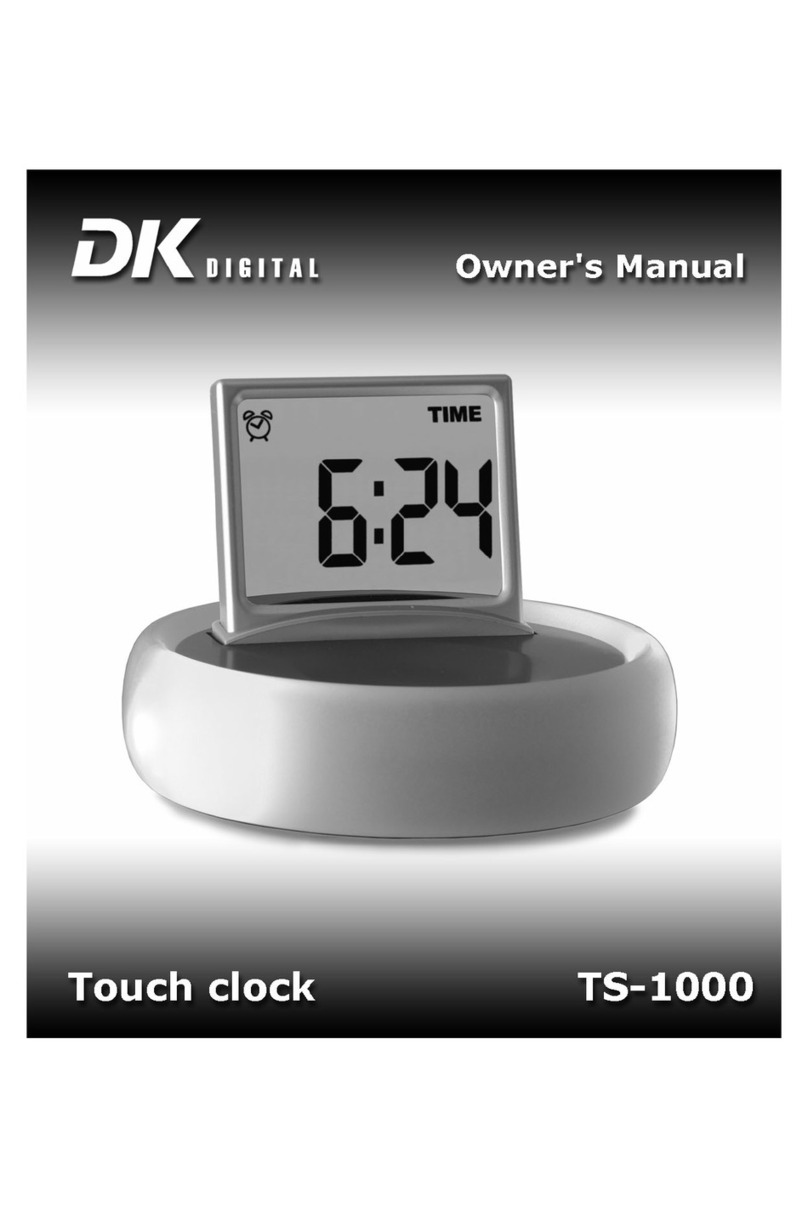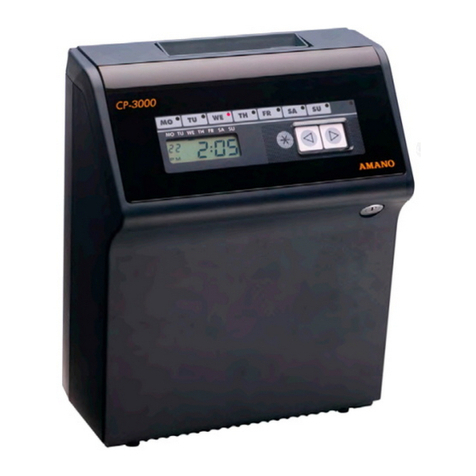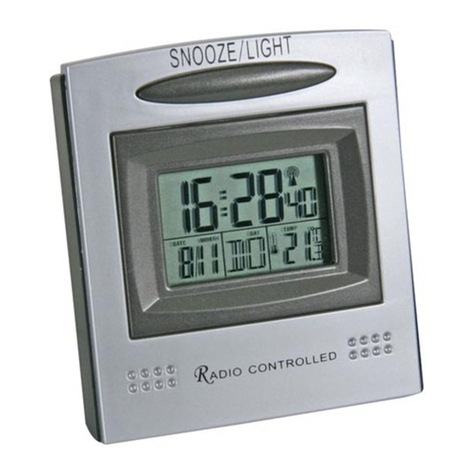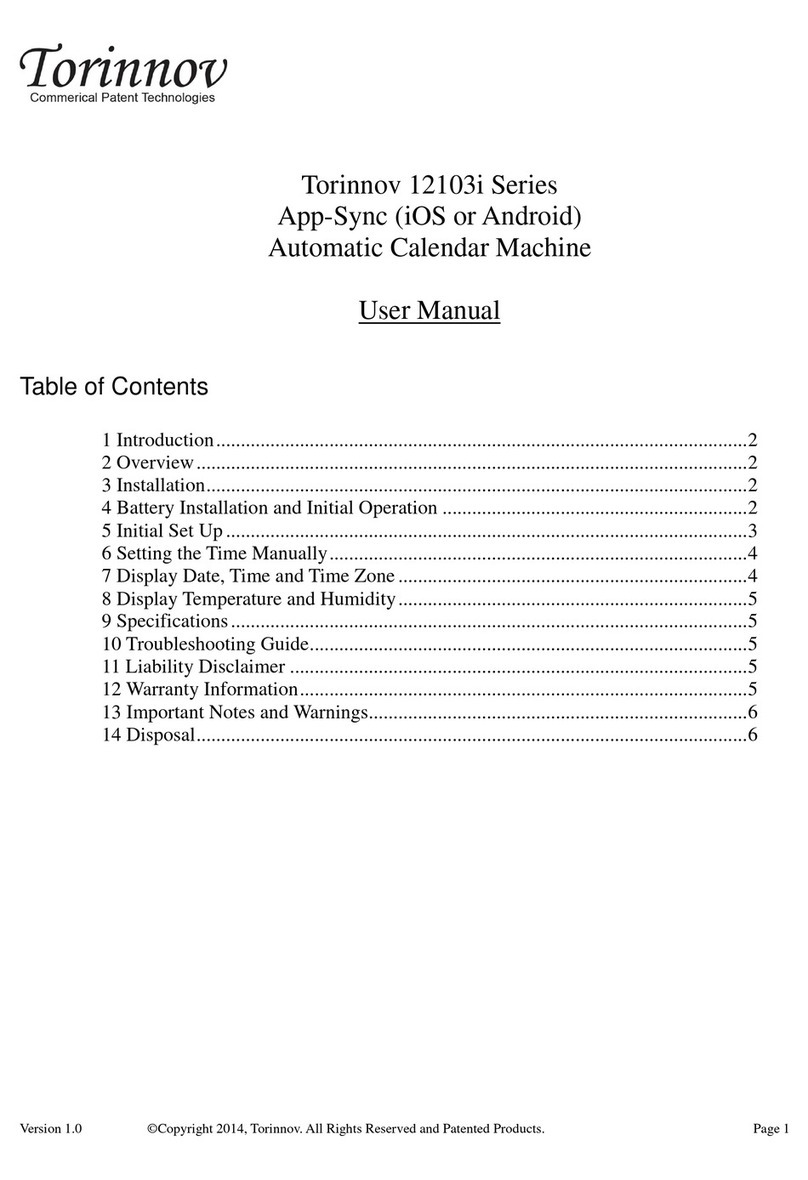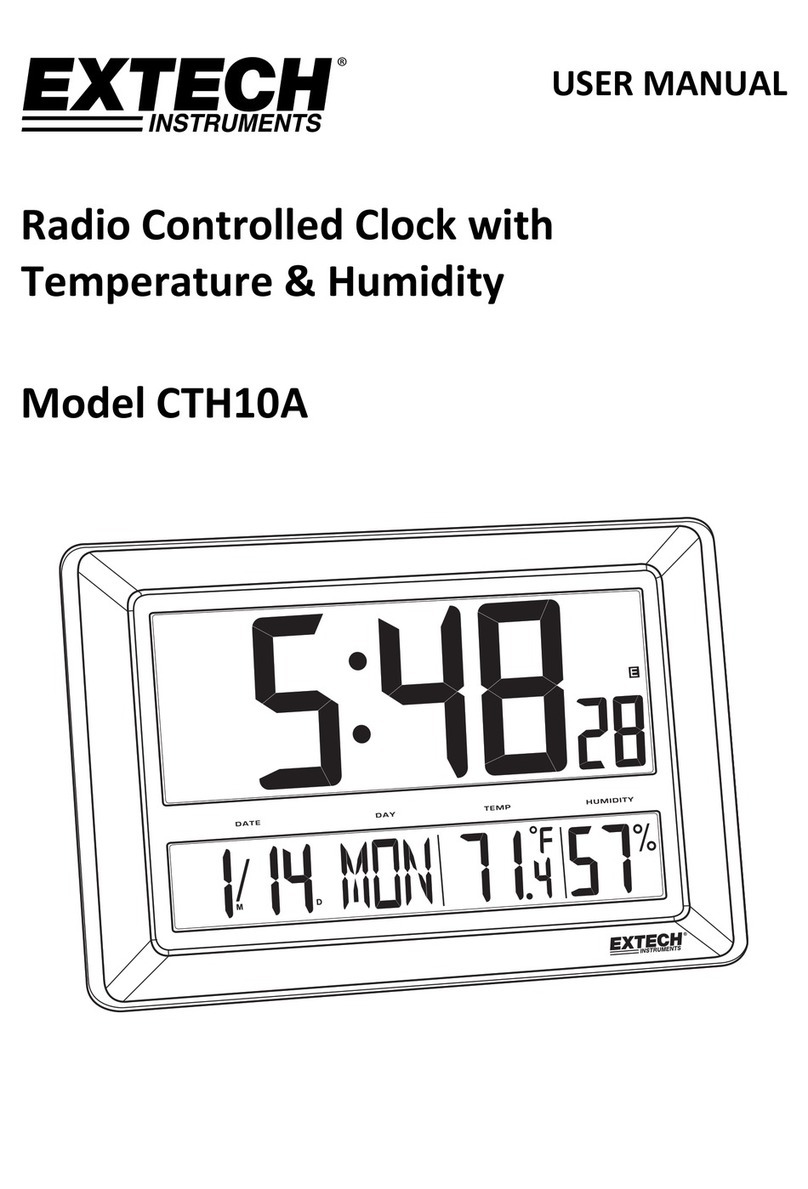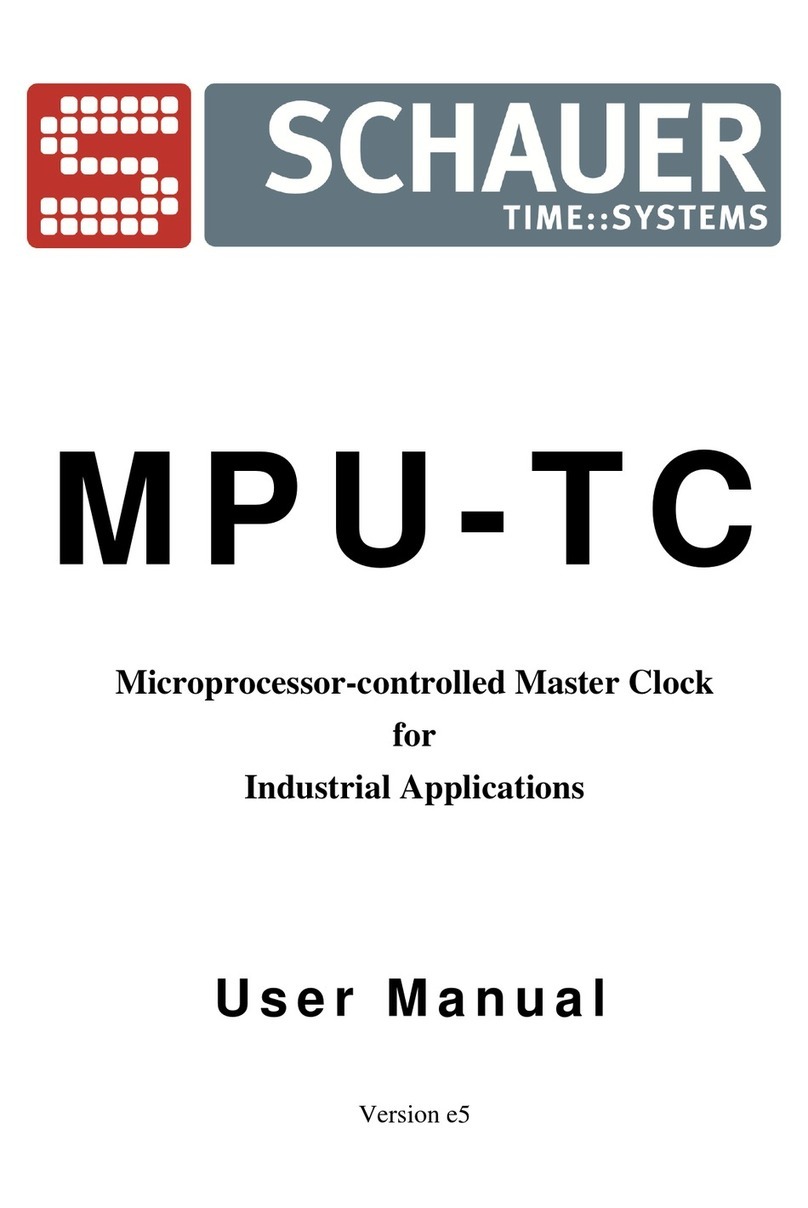Nixie Z566 Configuration guide

Single Digit Nixie Tube Clock ‘Z566’
www.pvelectronics.co.uk - 1 -
Assembly Instructions
And
User Guide
Single Digit Nixie Tube
Clock ‘Z566’
Software version: 12R
Hardware Revision: 28/08/08

Single Digit Nixie Tube Clock ‘Z566’
www.pvelectronics.co.uk - 2 -
1. INTRODUCTION
1.1 About the clock
Single Digit Nixie Tube Clock ‘Z566’ is a single tube clock utilising a
single nixie tube type Z566M, Z5660M, ZM1040, ZM1042 for the
display. It is a compact design with all components and tube
mounted on a single PCB.
The above types of tube, with a digit height of 30mm, are amongst
the largest nixie tube that can still be obtained in reasonable
quantities. These tubes are principally European in origin and were
produced during the 1970’s and 1980’s, when the technology was
at it’s most advanced. It is expected that the tube will last for very
many years and should not need replacing.
1.2 Clock Features
Single Digit Nixie Tube Clock ‘Z566’ has the following features:
- Hours and Minutes display on a single tube
- Uses the mains AC as the timebase
- Selectable at power-up to work with 50Hz (Europe) or 60Hz
(Americas)
- 12 or 24 hour modes, selectable at power-up
- Simple time setting using two buttons
- Maintains time during setup mode, eg. When changing between
Standard time and Daylight Savings Time
- Three display modes: normal flashing digits , fade-in, and fade-
in-fade-out

Single Digit Nixie Tube Clock ‘Z566’
www.pvelectronics.co.uk - 3 -
1.3 SAFETY
DANGER: The clock pcb includes a switched-mode voltage booster
circuit. This generates nominally 160 Volts DC, but is capable of
generating up to 300 Volts before adjustment. Assembly may only be
undertaken by individuals who are suitably qualified and experienced in
electronics assembly, and are familiar with safe procedures for working
with high voltages. If in doubt, refer to a suitably qualified engineer
before proceeding.
The voltages generated by this circuit can give a potentially
LETHAL ELECTRIC SHOCK.
DISCLAIMER: This product is supplied as a kit of parts, intended only for
suitably qualified electronic engineers, who are suitably qualified and
experienced in electronics assembly, and are familiar with safe
procedures for working with high voltages. The supplier, his agents or
associates accept no liability for any damage, injury or death arising from
the use of this kit of parts.
This is not a finished product, and the person assembling the kit is
responsible for ensuring that the finished product complies with any
applicable local regulations governing electrical equipment, eg. UL, CE,
VDE.

Single Digit Nixie Tube Clock ‘Z566’
www.pvelectronics.co.uk - 4 -
2. TOOLS AND EQUIPMENT REQUIRED
2.1 Tools required to assemble the PCB
The following tools will be required to assemble the PCB:
-Soldering iron with a small tip (1-2 mm)
-Wire cutters (TIP: A small pair of nail clippers works very well
for this function)
-Wire strippers (TIP: A small pair of scissors is quite suitable)
-Multimeter
-Small flat screwdriver for adjusting the high voltage supply
2.2 Materials you will need
Solder – lead / tin solder is preferred. Lead – free solder, as now
required to be used in commercial products in Europe, has a much
higher melting point and can be very hard to work with.
Desoldering wick (braid) can be useful if you accidentally create
solder bridges between adjacent solder joints.
2.3 Other items you will need
The clock kit does not include a power adapter. This is because the
kit is sold to many countries around the world, each with very
different household mains outlet socket types. It is more efficient
for the user to buy a suitable adapter locally. This saves shipping a
heavy adapter with the kit, and also the extra costs of managing
stocks of many varied power adapters.
The type of power adapter can be obtained at very low cost. The
following type of adapter should be obtained and used with the kit:
Mains AC to AC adapter (This is important, as the AC signal is
needed for the timebase)
Output 9-12V AC
Minimum power output capability of 250 mA
Output plug: 2.1mm pin
A suitable adapter is shown in figure 1 below:
Figure 1

Single Digit Nixie Tube Clock ‘Z566’
www.pvelectronics.co.uk - 5 -
3. LIST OF COMPONENTS
3.1 Table of components (In sequence)
Circuit
Designation Part Description
Resistors
R1 390K, ¼ Watt
R2 2.2K, ¼ Watt
R3 33K, ¼ Watt
R4 10K, ¼ Watt
R5 100R, ¼ Watt
Capacitors
C1 470uF, 16-25V, Electrolytic
C2 100uF, 16-25V, Electrolytic
C3 100nF ceramic
C4 330pF ceramic
C5 1uF, 250V, Electrolytic
C6 22nF, ceramic or polyester
C7 100nF ceramic
Transistors
Q1 IRF730 N-Channel MOSFET
Diodes
D1-D4 1N4001
D5 1N4936 fast recovery diode
D6 5.6V Zener Diode
Integrated Circuits
IC1 78L05 5V voltage regulator
IC2 MC34063A boost controller
IC3 PIC16F627A 8 bit
Microcontroller
IC4 74141 / K155N Nixie driver
Miscellaneous
L1 100uH – 220uH Inductor
NX1 ZM1042 Nixie tube or equiv
SW1, SW2, SW3 Miniature push button
VR1 1K Potentiometer
PCB PCB
IC Socket 18 Way IC Socket for IC3
CONN 2.1mm DC connector female
Cable ~60mm two way cable
SKT1-11 1mm Harwin solder-in
socket

Single Digit Nixie Tube Clock ‘Z566’
www.pvelectronics.co.uk - 6 -
3.2 Parts list / Packing sheet
Part Description Quantity
Resistors
33K, ¼ Watt 1
10K, ¼ Watt 1
2.2K, ¼ Watt 1
100R, ¼ Watt 1
390K, ¼ Watt 1
Capacitors
470uF, 16-25V, Electrolytic 1
100uF, 16-25V, Electrolytic 1
1uF, 250V, Electrolytic 1
330pF ceramic 1
100nF ceramic 2
22nF, ceramic or polyester 1
Transistors
IRF730 N-Channel MOSFET
1
Diodes
1N4001 4
1N4936 fast recovery diode 1
5.6V Zener Diode 1
Integrated Circuits
78L05 5V voltage regulator 1
MC34063A boost controller 1
PIC16F627A 8 bit
Microcontroller 1
74141 / K155N Nixie driver 1
Miscellaneous
100uH – 220uH Inductor 1
ZM1042 Nixie Tube 1
Miniature push button 3
1K Potentiometer 1
PCB 1
IC Socket, 18 way DIL 1
2.1mm DC connector female
1
Cable – 60mm piece 1
1mm Harwin solder-in
socket 11
It is recommended that the kit is checked against the list above, to
ensure all parts are present before commencing assembly.

Single Digit Nixie Tube Clock ‘Z566’
www.pvelectronics.co.uk - 7 -
3.3 How to identify the correct components
Resistors:
The resistors are easy to identify by the coloured bands
across the cylindrical body. Using a multimeter it should will
be possible very quickly to identify the different values.
Capacitors:
Take care when identifying the 2 small ceramic or polyester
capacitors. Depending on part availability, 2 or more different
types may be supplied. The 22nF capacitor (C6) may be
marked 22nF, 22n, or 223.
Transistors:
The MOSFET Q1 can easily be identified as it has a large
metal heatsink. Note: Due to part availability, this part may
be substituted for a different but equivalent part number so
the part marking may not necessarily be IRF730
Diodes:
The four 1N4001 diodes Q1-Q4 are black and are marked
1N4001. 1N4007 diodes may be supplied instead. The other
black diode is Q5, and again due to part availability it may be
substituted for an equivalent.
D6 is the small, glass bodied diode.

Single Digit Nixie Tube Clock ‘Z566’
www.pvelectronics.co.uk - 8 -
4. ASSEMBLY OF THE PCB
4.1 Diodes D1-D4
Start by bending the leads of the four diodes to approximately
match the spacing of the holes on the PCB. Insert the four diodes
taking care to match up the white bands on the components with
the component marking on the PCB. See Figure 2 below.
Figure 2
Solder in the diodes, then using the wire clippers trim off the leads.
4.2 IC1, IC2
Align the flat on IC1 with the marked flat on the PCB. IC2 must be
oriented correctly. The notch or dot at one end corresponds to pin
1. This goes into the SQUARE pad. Solder both components in and
trim the leads of IC1.
Figure 3

Single Digit Nixie Tube Clock ‘Z566’
www.pvelectronics.co.uk - 9 -
4.3 C3, C4, D5
Take care to place D5 with the white band on it’s body aligned with
the white band marking on the PCB.
Figure 4
4.4 C1, C2 and C5
Now it is time to solder in the three electrolytic capacitors. These
components must be placed the correct way round or else the
circuit will fail. Each capacitor has a positive lead, which has the
longer lead, and a negative lead, marked by a white or grey stripe
on the body. In Figure 5, the longer lead (+ve) and white stripe (-
VE) can be clearly seen.
Figure 5: C5, C2, C1
Place each component with the longer lead on the hole marked ‘+’.
Solder in and trim the leads. See figure 6 below:

Single Digit Nixie Tube Clock ‘Z566’
www.pvelectronics.co.uk - 10 -
4.5 Inductor L1
Place L1 in position, and ensure it is as close to the board as
possible. The leads of the component may not match exactly the
spacing on the board – this is perfectly normal. You can slightly
form the leads so it is a nice firm and snug fit to the board. Solder
and trim the leads as short as possible.
4.6 R1, R2, VR1.
Bend the leads of the resistors as show in figure 7 below.
Now place and solder in R1, R2 and VR1 as shown:
Figure 7: Resistor
leads formed for
mounting upright.
Figure 6: Correct
placement of C1, C2,
C5
Figure 8: R1, R2, VR1

Single Digit Nixie Tube Clock ‘Z566’
www.pvelectronics.co.uk - 11 -
4.7 MOSFET Q1, R5
The leads of Q1 must be bent so that is sits neatly over D5. Bend
the leads FIRST, then insert Q1 into the pcb. You will find it sits
very neatly on D5. This lowers the profile of the overall board and
stops the large heatsink fouling your case. The switches will be the
tallest items on the PCB. This is shown well in figure 9 below. Also
install R5 at this stage.
Figure 9. MOSFET
bent over to lower
the board profile.

Single Digit Nixie Tube Clock ‘Z566’
www.pvelectronics.co.uk - 12 -
4.8 Testing the Switched mode (160V) and regulated (5V)
power supplies
If you have reached this point and followed the correct order, then
all the components for the 160V and 5V power supplies should now
be on the board, and it is recommended that at this point the
power supplies are tested before proceeding. To do so, you will
need to make up the power input cable and socket, and of course
have the 9-12V AC power adapter to hand. Also at this stage you
will need a small flat blade screwdriver and a multimeter.
DANGER: At this point, observe the safety warnings in section 1.3.
When powered up, the board will generate up to 300V DC, and live
parts are exposed. Observe high-voltage precautions.
4.8.1 Making up the power input cable
Take the length (approx 60mm) of two way cable provided and
strip the insulation for about 5 mm from all four ends. Note, the
cable may be a different colour to that shown, and the insulation
may be the same colour for both sides. As this cable carries AC,
the conductors are not polarised. Referring to Figures 11-14, tin
the ends of the cables, and solder to the 2.1mm connector as
shown. Only 2 tags are used on the connector.
Figure 11: Connector and
60mm piece of two way
cable.

Single Digit Nixie Tube Clock ‘Z566’
www.pvelectronics.co.uk - 13 -
Connect the other ends of the cable to the circuit board as
shown in Figure 14. It is not necessary to feed the wire through
the holes, you can just lay the tinned ends over the pads and
solder in place.
Figure 12: Strip the insulation
from the cable ends, and tin
the copper conductors.
Figure 13: Close-up showing
which two tags need to be
connected.
Figure 14:
Connect the
power input
leads to the pads
on the PCB

Single Digit Nixie Tube Clock ‘Z566’
www.pvelectronics.co.uk - 14 -
4.8.2 Testing the power supplies
Use the GND, 5V and ‘170V’ test points to test first the 5V
supply, then the 160V supply. Adjust the position of VR1 until
the voltage is 160V. 160V is normally sufficient for good tube
brightness. You can adjust the voltage up to the full 170V later
if you want the tube to be brighter. When all is in order,
disconnect the power supply. Take care, as the output capacitor
can still hold charge at 160V after the supply is disconnected.
Before proceeding with the rest of the PCB assembly, it is a
good idea to de-solder the power input cable, as it can get in
the way when soldering the remaining components.
4.9 Socket for IC3, IC4
Insert the 18 Way IC socket into the PCB, ensuring that the notch
at one end is aligned with the corresponding mark on the PCB.
Insert IC4 directly into the PCB. Solder both components in place,
but do NOT insert IC3 at this stage. This will be inserted at the
very end of the assembly.
4.10 R3, R4, C6, D6,
R3 and R4 should be placed vertically. The lead pitch of C6 may not
match exactly the pitch of the holes on the PCB. If so, bend the
leads sufficiently to insert the component. D6 needs to be placed
the correct way round, so ensure the black band on the component
body aligns with the band on the PCB marking.
4.11 1mm Nixie tube sockets.
There are 11 individual 1mm sockets to solder in. The following is a
convenient way to install the sockets:
Place all the sockets, then place a flat object over the top of the
sockets to keep them from falling and invert the PCB to solder the
sockets in place. A third hand, from a helper, is most useful at this
stage!
Figure 15: IC4 and
the socket for IC3

Single Digit Nixie Tube Clock ‘Z566’
www.pvelectronics.co.uk - 15 -
Do not insert the Nixie tube at this stage.
4.12 Mode, Hr, Min
Push buttons Mode, Hr, Min can be mounted on either the
component or the tube side of the board, depending on your own
particular clock case design. If you are not 100% sure of the final
design at this stage, it is possible to just clip the switches into
place, and they will make a sufficiently good electrical contact to
complete the test and setup of the clock.
4.14 C7
Filter capacitor C7 needs to be installed directly across the 5V and
Gnd supply lines into the PIC processor, IC3. Cut and form the
leads, then solder as shown in figure 16 below. Solder to the
middle two pins on the tube side of the pcb.
5. FINAL TESTING OF PCB
All components should now have been installed. Make a final check
that all components are well soldered in, and that there are no solder
bridges – unintentional solder links between adjacent pins.
Insert IC3, matching up the notch on the resin body with the notch on
the socket and the PCB markings.
Insert the Nixie tube into it’s sockets. Do not insert too hard, or you
may break the glass seal at it’s base.
Re-solder the power input cable, if you removed it for ease of
assembly.
Figure 16: Filter
capacitor C7

Single Digit Nixie Tube Clock ‘Z566’
www.pvelectronics.co.uk - 16 -

Single Digit Nixie Tube Clock ‘Z566’
www.pvelectronics.co.uk - 17 -
6. HOW TO OPERATE THE CLOCK
The three buttons have the following functions:
Mode: Set display mode
Hr: Set Hours
Min: Set Minutes
Setting 50Hz or 60Hz operation and 12 or 24 hour modes
With the clock powered off, hold ‘Mode’ down. Power up the clock. Press
‘Mode’ again to select from the following options which are displayed on
the tube:
1 60 Hz, 12 Hour mode
2 60 Hz, 24 Hour mode
3 50 Hz, 12 Hour mode
4 50 Hz, 24 Hour mode
When you have selected the appropriate option, power off the clock, and
the setting is stored to flash memory.
Setting the time:
Press and hold either ‘Hr’ or ‘Min’ to set either Hours or Minutes
respectively. When the button is being held, and for a short period after
release, the clock will show only the minutes or hours that are being
adjusted.
Setting Display Mode
The three display modes are as follows, and are indicated by the tube
displaying the mode number for a short period then reverting to time
display:
1. Normal display: digits flash on and then off
2. Fade A: digits fade in and then flash off
3. Fade B: digits fade in and fade out
Press and hold ‘Mode’ until the desired mode is displayed on the tube
then release.

Single Digit Nixie Tube Clock ‘Z566’
www.pvelectronics.co.uk - 18 -
7. CIRCUIT DIAGRAM
Table of contents
Other Nixie Clock manuals

